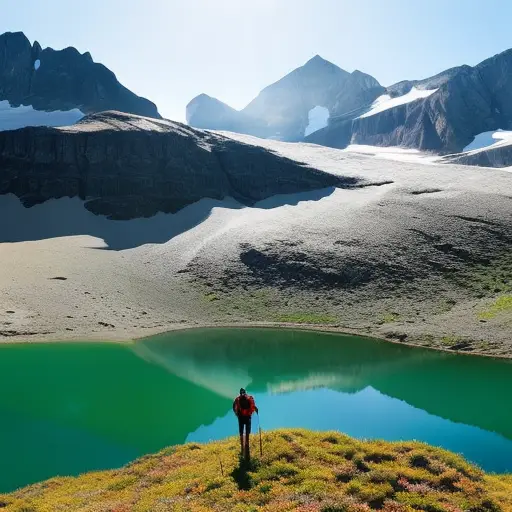The Role of Climate Change in Wilderness Survival Challenges

In the vast wilderness, where nature’s unpredictability reigns supreme, climate change emerges as an insidious adversary. Like a relentless storm, it alters the very fabric of survival, challenging our ability to adapt and endure.
This article delves into the role of climate change in wilderness survival challenges, examining the changing weather patterns, rising temperatures, and impacts on water availability and ecosystems. Through a scientific lens, we explore the evidence-based strategies and new adaptations necessary to navigate this treacherous terrain.
Changing Weather Patterns and Increased Unpredictability
Changing weather patterns and increased unpredictability pose significant challenges for wilderness survival. Climate change has led to noticeable shifts in weather patterns, with more frequent and intense extreme weather events such as storms, hurricanes, and heatwaves. These changes have made it increasingly difficult for individuals to predict and prepare for the conditions they may encounter in the wilderness.
One of the key impacts of changing weather patterns is the increased unpredictability in precipitation. In some regions, rainfall has become more erratic, with longer dry spells followed by intense rainfall events. This makes it harder for individuals to rely on traditional methods of collecting water, as they cannot predict when and where it will rain. Additionally, the unpredictability of rainfall can affect the availability of food sources and wildlife behavior, further complicating survival strategies.
Furthermore, changing weather patterns have also resulted in shifts in temperature patterns. Some regions are experiencing more frequent and intense heatwaves, while others are facing colder temperatures and extreme cold events. These temperature fluctuations can pose significant challenges for wilderness survival, as individuals must adapt to extreme heat or cold, which require different strategies for shelter, clothing, and hydration.
Rising Temperatures and Heat-Related Challenges
The impact of climate change on wilderness survival extends to rising temperatures and the resulting heat-related challenges. As global temperatures continue to rise, individuals venturing into the wilderness face an increased risk of heat exhaustion and dehydration. Heat exhaustion occurs when the body overheats and is unable to cool itself down, leading to symptoms such as dizziness, nausea, and fatigue. Dehydration, on the other hand, occurs when the body loses more fluids than it takes in, leading to an imbalance in electrolytes and potential organ failure.
Rising temperatures exacerbate these risks by increasing the rate of water loss through sweat and evaporation. As temperatures climb, the body’s natural cooling mechanisms become less effective, making it harder to maintain an optimal internal temperature. This is particularly concerning in wilderness survival situations where access to clean drinking water may be limited.
The combination of heat exhaustion and dehydration can have severe consequences, including heatstroke, organ damage, and even death. Therefore, it is crucial for individuals venturing into the wilderness to prioritize heat management and hydration. This may involve wearing appropriate clothing, seeking shade during peak temperatures, and drinking sufficient amounts of water to replace the fluids lost through sweating.
The rising temperatures and heat-related challenges associated with climate change have a direct impact on water availability and purification, which will be discussed in the subsequent section.
Impacts on Water Availability and Purification
Rising temperatures and heat-related challenges not only affect the risk of heat exhaustion and dehydration but also have significant impacts on water availability and purification in wilderness survival situations. As climate change continues to progress, water scarcity becomes a growing concern in many regions around the world. Higher temperatures can lead to increased evaporation rates, reducing the availability of freshwater sources such as rivers, lakes, and groundwater. This scarcity of water poses a considerable challenge for individuals stranded in the wilderness, as access to clean and safe drinking water becomes limited.
Furthermore, climate change can also impact water purification processes. As temperatures rise, the risk of waterborne diseases also increases. Pathogens, such as bacteria and viruses, thrive in warmer environments, making contaminated water sources more prevalent. This poses a significant health risk to individuals who rely on these water sources for survival.
In order to address the challenges of water availability and purification in wilderness survival situations, it is crucial to develop efficient methods of water collection, filtration, and purification. Additionally, education and awareness programs should be implemented to ensure that individuals are equipped with the necessary knowledge and skills to identify and treat waterborne diseases.
The impacts of climate change on water availability and purification highlight the need for proactive measures to adapt and mitigate its effects. With the increasing frequency and intensity of extreme weather events, the challenges faced in wilderness survival situations are only expected to worsen.
Increased Frequency and Intensity of Extreme Weather Events
With the growing impact of climate change, wilderness survival challenges are amplified by the escalating frequency and intensity of extreme weather events. These events, including hurricanes, droughts, floods, and wildfires, pose significant risks to individuals venturing into the wilderness. Climate change has led to an increase in the occurrence of these extreme weather events, making it crucial for individuals to be equipped with the necessary knowledge and skills to navigate and survive such conditions.
| Extreme Weather Event | Impact on Wilderness Survival Challenges |
|---|---|
| Hurricanes | Pose a threat to safety and shelter, and require emergency preparedness and evacuation plans. |
| Droughts | Limit water availability and increase the risk of dehydration, emphasizing the need for water conservation and purification techniques. |
| Floods | Increase the difficulty of navigation, potentially leading to isolation and the need for search and rescue operations. |
| Wildfires | Pose a risk to individuals’ safety and require individuals to be knowledgeable about fire safety and evacuation procedures. |
To mitigate the risks associated with the increased frequency and intensity of extreme weather events, emergency preparedness plans should be tailored to address climate change impacts. This includes equipping individuals with the necessary skills and knowledge to survive and respond to these events. Furthermore, search and rescue operations should be enhanced to account for the changing dynamics of wilderness survival challenges in the face of climate change.
Transition: As extreme weather events continue to impact wilderness survival, the alteration of ecosystems and its subsequent effects on food sources become an important aspect to consider.
Altered Ecosystems and Impacts on Food Sources
As climate change continues to affect wilderness survival challenges, the alteration of ecosystems has significant implications for individuals’ access to and availability of food sources. The impacts on foraging and biodiversity loss are particularly concerning in this context.
Climate change has led to shifting weather patterns, including changes in temperature and precipitation, which in turn affect ecosystems and the distribution of plant and animal species. These alterations can disrupt the delicate balance of food sources that are crucial for survival in the wilderness.
One major impact of altered ecosystems is the disruption of foraging patterns. As plants and animals respond to changing environmental conditions, the timing and availability of food sources can be disrupted. For example, warmer temperatures may cause certain plant species to flower earlier or later than usual, making it more difficult for foragers to rely on them as a consistent food source. Similarly, changes in animal behavior, such as migration patterns, can affect the availability of prey species for those who rely on hunting.
Furthermore, climate change has been linked to biodiversity loss, which further exacerbates the challenges of finding reliable food sources in the wilderness. As species become extinct or their populations decline, the diversity of available food sources decreases. This can lead to an over-reliance on a limited number of species, which increases the vulnerability of individuals to food shortages and potential starvation.
Adaptation and New Strategies for Wilderness Survival
One key aspect in addressing the challenges of wilderness survival in the face of climate change is the implementation of innovative strategies and adaptations. As the climate continues to change, it is crucial to develop and utilize new technology to aid in survival. For example, advancements in satellite technology have allowed for better navigation and communication systems in remote wilderness areas. This enables individuals to have a greater understanding of their surroundings and access to emergency assistance if needed.
In addition to new technology, psychological resilience is also a critical factor in wilderness survival. Climate change not only presents physical challenges but can also have significant psychological impacts on individuals. Developing strategies to enhance psychological resilience can help individuals cope with the stress and uncertainty associated with survival situations. This may include techniques such as mindfulness, positive self-talk, and stress management.
Furthermore, it is essential to adapt traditional survival skills and strategies to align with the changing climate. For instance, individuals may need to modify their shelter-building techniques to withstand more extreme weather events. Additionally, understanding the changing behavior and migration patterns of wildlife can aid in securing food sources.
Frequently Asked Questions
How Does Climate Change Affect the Behavior of Animals in the Wilderness?
Climate change has significant impacts on ecosystem dynamics and wildlife behavior. It can alter their habitats, disrupt food availability, and lead to changes in migration patterns. These changes can have profound consequences for the survival of animals in the wilderness.
Are There Any Specific Regions or Wilderness Areas That Are More Vulnerable to Climate Change Impacts?
Vulnerable regions to climate change impacts include Arctic, coastal areas, and mountainous regions. Rising temperatures, melting ice, and sea-level rise pose threats to ecosystems and indigenous communities. Adaptation strategies are necessary to mitigate these challenges.
Is There a Correlation Between Climate Change and the Spread of Infectious Diseases in the Wilderness?
Climate change can potentially impact the spread of infectious diseases in the wilderness. Understanding the link between climate change and the behavior of animals in the wilderness is crucial in exploring this correlation.
What Are Some Potential Long-Term Consequences of Climate Change on Wilderness Survival?
Potential long-term consequences of climate change on wilderness survival include increased frequency and intensity of extreme weather events, reduced availability of clean water and food sources, and the need for climate change adaptation strategies and improved wilderness survival techniques to mitigate these challenges.
How Can Individuals Prepare Themselves for the Challenges Posed by Climate Change in the Wilderness?
To prepare for the challenges posed by climate change in the wilderness, individuals must engage in emergency planning and acquire essential survival skills. This ensures their ability to adapt and respond effectively to changing environmental conditions.
Conclusion
In conclusion, climate change poses significant challenges for wilderness survival. Changing weather patterns, rising temperatures, and increased frequency of extreme weather events all contribute to the unpredictability and difficulty of surviving in the wild.
Furthermore, impacts on water availability, altered ecosystems, and changes in food sources further exacerbate these challenges. As a result, adaptation and the development of new strategies are crucial for individuals to navigate the increasingly harsh and unforgiving conditions.
Survival in the wilderness has become a daunting task, requiring immense resilience and resourcefulness.




